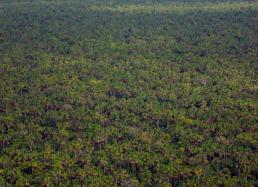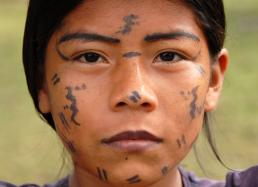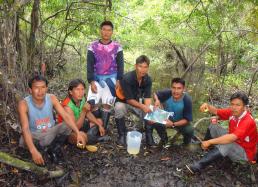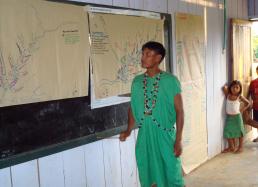The Rapid Inventory of Cuyabeno-Güeppí
The Cuyabeno-Güeppí region spans three countries and represents a complex of protected areas, almost protected areas, and scattered human settlements:
- In Peru, the Güeppí Reserved Zone (Zona Reservada Güeppí) provisionally sets more than 1.5 million acres aside for conservation.
- In Ecuador, the Cuyabeno Wildlife Reserve (Reserva de Producción Faunística Cuyabeno) is a nearly 1.5-million-acre area officially safeguarded within the Ecuadorian protected area system.
- In Colombia, the La Paya National Park (Parque Nacional Natural La Paya) contains more than one million acres.
All three areas represent some of the most remote and inaccessible areas in each country, and currently there is no integrated management of these areas among the three countries.
Culturally the area is also complex. In Peru, there are three indigenous groups: Secoya, Huitoto, Kichwa. In Ecuador, there are Cofan, Secoya, and Kichwa. In Colombia, there are Huitoto, Siona, Cofan, Kichua, and Coreguáje. And in all three countries there are mestizo (people of mixed indigenous-European ancestry) communities. Although these groups have their own traditions and ideas, many of them have begun to find common ground.
The Biological Inventory
In late 2007, Dr. Corine Vriesendorp led The Field Museum's team of U.S., Peruvian, and Ecuadorian biologists, along with Cofan, Huitoto, Kichwa, and Secoya naturalists, in a survey of five different sites in the Cuyabeno-Güeppí region—two in Ecuador and three in Peru (Colombia is currently too dangerous.) The Advance Team went in ahead of the scientists to set up basic camp and open up kilometers of trails that reach as many different habitat types as possible (identified from the satellite images), so that the scientists could hit the ground running when they arrived a week later. Traveling from site to site by land, river, and float planes, the team stayed four full days at each of the five locations, identifying and cataloging plants, fishes, frogs, snakes, birds, large mammals, and bats.
The Social Inventory
Conducted entirely in Peru, the Social Inventory focused on understanding the social strengths of the communities living in and around the Zona Reservada Güeppí. The team of social scientists traveled to the Napo and Putumayo drainages via float plane. They visited more than a dozen Secoya, Kichwa, Huitoto, and mestizo communities, sharing in daily activities and engaging local residents in conversations about natural resource use and their aspirations for the future.
Together, the Biological and Social Inventories allowed the team to understand:
1. the aspirations of the people living in the region,
2. the biological value of the Cuyabeno-Güeppí region, and
3. the opportunities for Ecuador and Peru, and potentially Columbia, to work together to create real and long-lasting conservation in the area.
After nearly a month in the field, both teams met in Iquitos, Peru, to share their results, write their reports, and submit their integrated recommendations to the regional government. From there, the team traveled to Lima, Peru, and Quito, Ecuador, to present their results to the national government. The Final Report represents a tremendous opportunity to promote collaborative conservation between Ecuador and Peru, as well as engage nearby Colombia, in protecting the vast cultural and biological diversity of Amazonia.





